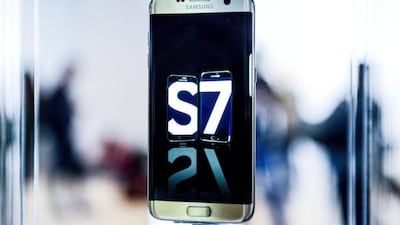Sluggish global smartphone sales are starting to crimp earnings at Samsung Electronics, which posted profit that fell short of estimates.
The maker of Galaxy phones reported that operating income rose to 14.8 trillion South Korean won ($13.2 billion) in the three months ended June, according to preliminary results released Friday from the Suwon, South Korea-based company. That compares with the 15.3 trillion-won average of analysts’ estimates compiled by Bloomberg.
Smartphone sales started to cool last year after a decade of robust growth, but Samsung had managed to weather the slowdown, thanks to demand for memory. While the world’s biggest chipmaker dominates in both DRAM and NAND markets, the company has struggled with weaker-than-projected sales of its Galaxy S9 smartphones unveiled in the first three months of the year. Sales of organic light-emitting diode screens to Apple have also been weaker than expected, while the growth of semiconductor prices has been slowing.
“While chip sales keep rising, smartphones aren’t looking good,” said Jung Sang-jin, a fund manager at Korea Investment Management. “While chips and phones cancel each other out in profit, the weakening won may work in Samsung’s favour in the second half.”
Sales for the second quarter fell to 58 trillion won, compared with the 60.8 trillion won average projection compiled by Bloomberg. Samsung will not provide net income or break out divisional performance until it releases final results later this month.
Shares fell as much as 2 per cent in Friday morning trade in Seoul. The stock has declined more than 11 per cent this year after trading near record highs in 2017.
Samsung warned in April that its mobile business would see “stagnant sales of flagship models amid weak demand and an increase in marketing expenses” in the second quarter. Samsung’s market share is forecast to fall to 20.4 per cent in the second quarter from 21.4 per cent in the previous quarter, while Huawei Technologies, Oppo and Xiaomi Corporation would all raise theirs, according to TrendForce. Chinese companies have also been challenging Samsung in the LCD television market where the South Korean manufacturer leads.
Samsung also faces an investigation in China over allegations of collusion in chip sales with Micron Technology and SK Hynix, while facing regulatory pressure at home over corporate governance.
__________
Read more:
Blackberry's KEY2 smartphone arrives in the Middle East, starting with the UAE, this month
World's most popular smartphone brands, Q1 2018
Apple and Samsung reach settlement in long-running patent fight
__________
The semiconductor business forms the largest portion of Samsung’s profit. Contract prices for 32-gigabyte DRAM server modules climbed 2.8 per cent in the June quarter from the March period, which saw them rise 5.6 per cent. Prices for 128 gigabit MLC NAND flash memory chips fell about 9 per cent, according to inSpectrum Tech.
Protectionism may end up benefiting the South Korean chipmaker if the US puts tariffs on Chinese imports and China retaliates, Jung at Korea Investment Management said. Samsung offers China an alternative to Micron in chips and US companies may look to Samsung for displays if Chinese firms like BOE Technology Group are hit, he said.
The won may also help Samsung to bounce back in the second half. The Korean currency has weakened sharply since early June after fears of a trade war reignited.
“The won depreciation is working in Samsung’s favour,” said Claire Kim, an analyst at Daishin Securities. “Samsung’s semiconductors sales are still beating expectations and chips are making more money than smartphones are losing.”

